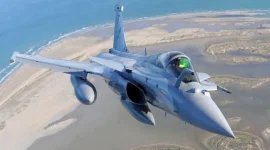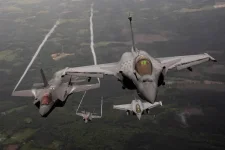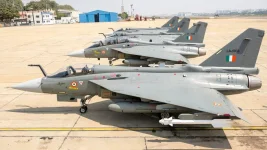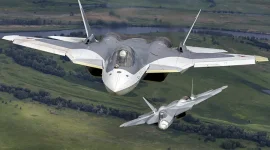- Views: 4K
- Replies: 23
The Indian Air Force (IAF) is conceptualizing a major advancement in its aerial warfare capabilities with plans for a future supersonic Unmanned Combat Aerial Vehicle (UCAV).
This forward-looking project aims for an aircraft capable of sustained supersonic flight (supercruise) and carrying a substantial internal weapons load of up to 4 tons, according to informed sources.
This long-term vision complements the IAF's more immediate focus on the Ghatak UCAV program. The Ghatak, currently under proposal by the Defence Research and Development Organisation's (DRDO) Aeronautical Development Establishment (ADE), is a 13-ton stealth drone designed with a 1.5-ton internal weapons capacity.
While the Ghatak represents the near-term priority, the potential development of a much larger, faster supersonic UCAV signifies the IAF's strategic planning for advanced, domestically produced unmanned systems capable of operating effectively in future complex air defence environments. However, this supersonic aircraft remains a distant objective, potentially 10 to 15 years away from becoming operational.
Currently, the IAF is concentrating on the Ghatak UCAV. This unmanned aircraft is being designed with stealth features, meaning it will incorporate technologies and shaping to reduce its visibility to enemy radar and heat-seeking sensors.
With a planned Maximum Take-Off Weight (MTOW) of 13 tons and the ability to carry around 1.5 tons of weapons internally, the Ghatak is intended for missions such as deep strikes into contested territory and reconnaissance. Its low-observable characteristics are considered vital for operations near sensitive border areas.
The development of Ghatak is expected to leverage experience gained from previous ADE projects, including the Rustom series of drones and the successful flight of the SWiFT (Stealth Wing Flying Testbed) technology demonstrator in 2022.
It is anticipated that the Ghatak will be powered by a non-afterburning version of the Kaveri engine, delivering subsonic speeds suited for endurance and payload delivery. Its 1.5-ton internal bay could carry weapons like the Smart Anti-Airfield Weapon (SAAW) or other precision munitions for roles such as suppressing enemy air defences (SEAD).
Looking further ahead, the IAF's ambition extends to the significantly more advanced supersonic UCAV. This concept involves an aircraft capable of supercruise – flying faster than the speed of sound continuously without using fuel-intensive afterburners – and carrying a 4-ton internal weapon load.
Such specifications would place it far beyond current drones like Russia's S-70 Okhotnik (around 2-2.5 ton capacity) and require an estimated MTOW of 35 to 40 tons, comparable to manned fighter jets like the Su-30MKI.
Propelling such a large and fast unmanned aircraft would likely require twin engines. Sources suggest these could potentially be derived from the engine planned for India's future Advanced Medium Combat Aircraft (AMCA), possibly 73kN dry thrust variants. This configuration could enable efficient supercruise speeds above Mach 1.2.
Combined with comprehensive stealth features (minimizing radar, heat, and noise signatures), this UCAV could potentially penetrate deep into hostile airspace to deliver a heavy payload, which might include multiple advanced missiles or even future hypersonic weapons.
Key design objectives for this conceptual supersonic UCAV include sustained Mach 1+ flight without afterburners, very low observability across different detection methods, the versatile 4-ton internal weapons bay, and sophisticated Artificial Intelligence (AI) for autonomous operations, while retaining human control for critical decisions.
Strategically, such an aircraft aims to ensure India maintains a technological edge, particularly considering advancements in stealth drone technology by regional players like China (GJ-11 Sharp Sword) and Russia (S-70 Okhotnik). A large, stealthy, supersonic UCAV with a potential range of 1,000-1,500 km could hold distant targets at risk while having a greater chance of surviving encounters with modern air defence systems.
Officials acknowledge that this supersonic UCAV project is not yet formally underway beyond initial conceptual definitions. It is viewed as a long-range goal, with potential induction timelines estimated around 2035-2040, reflecting the significant technological challenges, funding requirements, and development time needed for such an advanced system. The IAF reportedly aims for this to be an indigenous development, though collaborations might be necessary.




